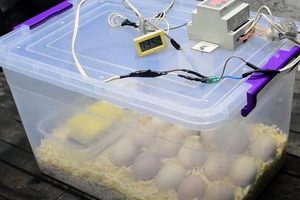The concept involves constructing a planter from a repurposed rain gutter component, prioritizing simplicity in design and assembly. As an example, consider using existing downspout sections, cutting them to a desired length, and capping the ends to create a trough for soil and plants; this process is characterized by its low complexity.
The appeal of this method lies in its cost-effectiveness, resourcefulness, and accessibility. Individuals can utilize readily available materials, often salvaged, to cultivate plants in a limited space. Historically, the re-use of materials for gardening and home improvement projects has been a practical response to economic constraints and an environmentally conscious approach.
The subsequent sections will explore specific construction techniques, plant selection considerations, and potential design variations associated with transforming these materials into functional and aesthetically pleasing gardening elements.
Construction and Maintenance Tips
This section provides essential guidelines for successfully implementing and maintaining a rain gutter-based planting system.
Tip 1: Material Selection: Opt for durable downspout materials, such as vinyl or aluminum, to withstand environmental exposure. Consider the gauge or thickness of the material to ensure structural integrity when filled with soil.
Tip 2: Drainage Implementation: Incorporate drainage holes along the bottom of the downspout planter to prevent waterlogging and root rot. Drill holes approximately every six inches to facilitate adequate water runoff.
Tip 3: End Cap Security: Secure end caps using appropriate adhesive or sealant to prevent leaks and maintain structural integrity. Ensure the sealant is rated for outdoor use and capable of withstanding temperature fluctuations.
Tip 4: Mounting Considerations: Securely mount the planter to a stable structure using brackets or hanging mechanisms designed to support the weight of the filled container. Ensure the mounting hardware is corrosion-resistant.
Tip 5: Soil Selection: Utilize a lightweight potting mix specifically formulated for container gardening to promote drainage and aeration. Avoid using heavy garden soil, which can compact and impede root growth.
Tip 6: Plant Selection: Choose plants with shallow root systems and compact growth habits suitable for container gardening. Consider factors such as sunlight exposure, water requirements, and mature size when selecting plants.
Tip 7: Regular Maintenance: Monitor soil moisture levels regularly and water as needed. Fertilize plants periodically according to their specific nutrient requirements. Remove any dead or diseased foliage to prevent the spread of pests and diseases.
Following these guidelines can ensure the longevity and productivity of the repurposed rain gutter garden, while also mitigating common issues associated with container gardening.
The subsequent section will address common challenges and troubleshooting techniques associated with these gardening systems.
1. Repurposed Materials
The utilization of repurposed materials forms a cornerstone of a simplified downspout planting endeavor. This approach not only reduces waste but also provides an economical and readily accessible means of constructing functional gardening containers.
- Source Acquisition
Repurposed downspouts can be sourced from construction sites, renovation projects, or salvage yards. Identifying and acquiring suitable materials often requires minimal investment, further contributing to the project’s overall cost-effectiveness. Proper cleaning and preparation are necessary to ensure the material’s suitability for plant cultivation.
- Material Modification
Adapting downspouts into planters necessitates basic modifications, typically involving cutting the material to the desired length and sealing the ends. These modifications require only fundamental tools and skills, aligning with the emphasis on simplicity. Precise measurements and secure seals are essential to prevent leaks and maintain the structural integrity of the planter.
- Environmental Impact
Employing repurposed materials directly contributes to waste reduction and promotes sustainable gardening practices. Diverting these materials from landfills lessens the environmental burden associated with manufacturing new products and disposal processes. This ecological advantage aligns with a growing emphasis on environmentally conscious landscaping and home improvement.
- Design Versatility
Repurposed downspouts offer design flexibility, allowing for customization to suit specific aesthetic preferences and spatial constraints. They can be painted, arranged in various configurations, or integrated into existing structures. This adaptability facilitates the creation of unique and personalized gardening solutions.
The strategic incorporation of repurposed materials into downspout planters demonstrates a commitment to resourcefulness and environmental responsibility. This approach offers a practical and accessible means of cultivating plants while minimizing environmental impact and maximizing design flexibility, emphasizing the “easy” aspect through readily available resources.
2. Simple Assembly
The attribute of simple assembly is intrinsically linked to the success of a “diy downspout planter easy” project. The ease of construction directly affects the accessibility and appeal of the project to a broader audience, including those with limited experience in DIY or gardening. The causal relationship is clear: intricate designs requiring specialized tools or techniques reduce the likelihood of successful completion, diminishing the projects overall benefit. For example, a design requiring only cutting the downspout to length, capping the ends with readily available adhesive, and adding drainage holes promotes broader adoption than one requiring welding or complex joinery. The importance of simple assembly is therefore paramount to the project achieving its intended purpose as an accessible and uncomplicated gardening solution.
The practicality of this understanding extends to material selection and design choices. Opting for lightweight materials simplifies handling and mounting, further reducing the complexity of the assembly process. Designs should prioritize modularity and ease of manipulation, avoiding complex curves or intricate connections. For instance, using pre-fabricated end caps that simply snap into place eliminates the need for specialized sealing techniques. Furthermore, clearly documented instructions with visual aids contribute significantly to the ease of assembly, guiding individuals through each step in a straightforward manner.
In summary, simp
le assembly is a critical determinant of the success of “diy downspout planter easy” projects. By prioritizing ease of construction through material selection, design simplification, and clear instructions, individuals can create functional and aesthetically pleasing planters with minimal effort. The challenges of complex designs can be mitigated by focusing on readily available materials and straightforward assembly techniques. This emphasis aligns with the broader theme of promoting accessible and sustainable gardening practices.
3. Minimal Tools
The characteristic of requiring only a limited set of tools is central to the “diy downspout planter easy” concept. This aspect significantly contributes to the project’s accessibility and broad appeal, facilitating participation by individuals with diverse skill sets and resource availability.
- Reduced Entry Barrier
The need for specialized or expensive equipment can deter individuals from undertaking DIY projects. A “diy downspout planter easy” initiative minimizes this barrier by relying on common household tools such as a saw, drill, measuring tape, and utility knife. This reduces the initial investment and increases the likelihood of project initiation and completion.
- Simplified Construction Techniques
The selection of construction methods directly correlates with the tools required. Projects utilizing minimal tools necessitate simpler techniques, such as cutting, drilling, and adhesive bonding. This emphasis on fundamental skills streamlines the construction process and reduces the potential for errors or complications.
- Enhanced Portability and Flexibility
The limited tool requirement enables individuals to undertake the project in various locations, irrespective of access to a fully equipped workshop. This portability enhances flexibility, allowing for on-site modifications and adjustments as needed. This adaptability is particularly beneficial in urban environments or smaller living spaces where dedicated workshop space may be limited.
- Cost Containment
Beyond the initial investment in tools, minimizing the required equipment translates to reduced maintenance costs and potential repair expenses. By limiting the number of specialized tools, individuals can avoid the recurring costs associated with upkeep and replacement, contributing to the overall cost-effectiveness of the project.
The focus on minimal tools in “diy downspout planter easy” projects serves to democratize gardening, making it more accessible and affordable for a wider audience. This approach not only simplifies the construction process but also promotes resourcefulness and adaptability, fostering a sense of accomplishment and encouraging participation in sustainable practices.
4. Space Efficiency
The concept of space efficiency is intrinsically linked to the practical applications and advantages of constructing planters from repurposed rain gutters. This focus on compact design directly addresses the needs of individuals with limited gardening space, offering a viable solution for cultivation in constrained environments.
- Vertical Gardening Potential
Repurposed downspouts can be readily adapted for vertical gardening configurations. By mounting the planters on walls, fences, or other vertical surfaces, individuals can maximize plant density within a limited footprint. This approach is particularly well-suited for urban environments or balconies where horizontal space is at a premium. For example, a series of downspout planters stacked vertically can support a diverse herb garden in a small area, demonstrating efficient space utilization.
- Linear Design Optimization
The inherent linear shape of downspouts lends itself to efficient use of narrow spaces. Planters can be strategically placed along walkways, railings, or window ledges, transforming previously underutilized areas into productive gardening zones. An example could be lining a narrow balcony with downspout planters filled with cascading flowers or vegetables, creating a visually appealing and functional space.
- Stackable Configurations
Downspout planters can be designed to interlock or stack, creating multi-tiered gardening systems. This approach allows for increased planting capacity without significantly expanding the horizontal footprint. A pyramid-shaped arrangement of downspout planters, for example, could accommodate a variety of plants with varying light requirements, optimizing space and resource allocation.
- Adaptability to Irregular Spaces
Downspouts can be cut and configured to fit into irregular or awkwardly shaped areas. This adaptability allows for the transformation of previously unusable spaces into productive gardening spots. An example would be custom-fitting downspout planters into corners or alcoves, maximizing the use of every available inch of space for plant cultivation.
The inherent space-saving characteristics of repurposed downspout planters make them an ideal solution for individuals seeking to maximize their gardening potential in limited areas. The adaptability and design flexibility of these planters allows for creative and efficient use of space, transforming underutilized areas into productive and visually appealing gardening zones. By prioritizing verticality, linearity, and adaptability, these gardening systems embody the principles of efficient space utilization.
5. Cost-Effective
The element of cost-effectiveness is a central tenet of the “diy downspout planter easy” approach, directly influencing its widespread appeal and practicality for individuals seeking affordable gardening solutions. A cost-conscious methodology ensures accessibility and promotes sustainable practices by minimizing financial investment.
- Material Repurposing and Acquisition
The utilization of recycled downspouts represents a primary cost-saving measure. Instead of purchasing new containers, materials are sourced from construction discards, renovation projects, or salvage yards, significantly reducing initial expenditure. The acquisition of these materials often involves minimal or no cost, thereby lowering the overall investment required for the project. An example is a homeowner utilizing discarded downspout sections from a roof repair, eliminating the expense of buying new planters. This repurposing approach minimizes both material costs and environmental impact.
- Reduced Tool Requirements
The “diy downspout planter easy” concept inherently necessitates only basic hand tools, thereby eliminating the need for specialized or expensive equipment. A saw, drill, measuring tape, and basic fasteners typically suffice for construction. This minimizes the initial investment in tools, rendering the project accessible to individuals with limited resources. An example is a project using a basic hand saw instead of a power saw for cutting downspouts, reducing costs and promoting a simpler construction process.
- Minimized Maintenance Expenses
The simpli
city of design and construction reduces the potential for maintenance-related expenses. The use of durable materials and basic construction techniques minimizes the likelihood of structural failures or component replacements. Additionally, the readily available nature of replacement parts, such as end caps or fasteners, ensures that repairs can be completed at minimal cost. For example, using UV-resistant paint on the downspouts extends their lifespan, reducing the frequency of replacements and lowering long-term costs. - Seedling and Soil Optimization
The compact nature of downspout planters promotes efficient use of soil and resources. The reduced volume of soil required compared to traditional garden beds or large containers translates to cost savings on soil amendments and fertilizers. Furthermore, the focused planting area encourages efficient water management, minimizing water waste and reducing associated utility costs. An example is starting seedlings in smaller downspout sections to optimize resource usage and reduce overall planting expenses before transplanting to larger containers or beds.
These interconnected facets highlight the comprehensive cost benefits associated with the “diy downspout planter easy” approach. By prioritizing material repurposing, minimizing tool requirements, reducing maintenance expenses, and optimizing resource utilization, this methodology presents a practical and affordable solution for individuals seeking to cultivate plants without incurring significant financial burdens. The low cost and easy construction promotes adoption and sustainable gardening practices, making it a compelling choice for those with limited resources.
6. Drainage Essential
Adequate drainage is an indispensable component for the successful implementation of any “diy downspout planter easy” project. The enclosed nature of a repurposed downspout, when converted into a planter, inherently lacks the natural drainage capabilities of open ground. Consequently, the absence of properly designed drainage mechanisms directly leads to waterlogged soil conditions. This, in turn, creates an anaerobic environment detrimental to plant root health. Without sufficient drainage, plant roots are deprived of essential oxygen, increasing the susceptibility to root rot and fungal diseases. For instance, seedlings planted in a downspout planter without drainage holes will likely exhibit stunted growth, yellowing leaves, and eventual demise due to waterlogged soil hindering nutrient uptake. Thus, the presence of effective drainage is not merely an optional feature but a fundamental requirement for sustaining plant life within these planters.
Implementing effective drainage strategies in a “diy downspout planter easy” project involves several practical considerations. Drilling appropriately sized and spaced drainage holes along the bottom of the downspout provides an immediate pathway for excess water to escape. The size and spacing of these holes must be carefully calibrated to balance drainage efficiency with soil retention. Using a well-draining potting mix, as opposed to dense garden soil, further aids in facilitating water movement away from plant roots. The addition of a layer of gravel or coarse material at the bottom of the planter creates a drainage zone, preventing soil from clogging the drainage holes and ensuring consistent water outflow. Elevating the planter slightly off the ground further promotes drainage by preventing the holes from becoming obstructed by the underlying surface.
In summary, the “diy downspout planter easy” concept is inextricably linked to the essential requirement of proper drainage. Addressing this aspect through appropriate hole placement, suitable soil selection, and implementation of drainage layers directly mitigates the risks associated with waterlogged conditions. Overlooking this fundamental consideration invariably leads to plant health issues and project failure, underscoring the practical significance of integrating effective drainage mechanisms into every “diy downspout planter easy” endeavor. The understanding is crucial to the broader theme of sustainable and effective gardening practices.
Frequently Asked Questions
This section addresses common inquiries regarding the construction and utilization of downspout planters, providing concise and informative responses.
Question 1: What type of downspout material is best suited for planter construction?
Vinyl and aluminum downspouts are commonly utilized. Vinyl offers durability and resistance to corrosion, while aluminum provides a lightweight and easily workable option. The selection depends on personal preferences and project requirements.
Question 2: How should drainage holes be implemented in downspout planters?
Drilling holes approximately 1/4 to 1/2 inch in diameter, spaced every 6 to 8 inches along the bottom of the downspout, is recommended. This spacing ensures adequate water drainage while preventing excessive soil loss.
Question 3: What type of soil is optimal for downspout planters?
A lightweight, well-draining potting mix specifically formulated for container gardening is advisable. This type of mix promotes aeration and prevents soil compaction, fostering healthy root development.
Question 4: How can downspout planters be securely mounted or supported?
Utilizing brackets, straps, or chains attached to a stable structure is crucial. Ensure the mounting hardware is appropriately sized and rated to support the weight of the filled planter.
Question 5: What plant varieties are best suited for downspout planters?
Herbs, succulents, and shallow-rooted vegetables such as lettuce and strawberries are generally well-suited. Consider plant size, light requirements, and growth habits when selecting plant varieties.
Question 6: How can the lifespan of downspout planters be extended?
Regular cleaning, application of protective coatings (such as UV-resistant paint), and proper winterization (if applicable) can prolong the lifespan. Avoid placing excessive weight or stress on the planter structure.
These FAQs provide essential guidance for successful downspout planter implementation. Adherence to these recommendations contributes to plant health and project longevity.
The subsequent section will delve into advanced design considerations and customization options for enhancing the aesthetic appeal of downspout planters.
Conclusion
This exposition has provided a detailed examination of the “diy downspout planter easy” concept, encompassing its foundational principles, construction techniques, and practical considerations. Emphasis has been placed on key aspects such as material repurposing, simplified assembly, minimal tool requirements, space efficiency, cost-effectiveness, and the critical importance of drainage. Through understanding these elements, successful implementation is more easily achieved, and the common pitfalls can be avoided.
By adhering to the established guidelines and embracing a resourceful approach, individuals can transform discarded materials into functional and aesthetically pleasing gardening solutions. This approach not only promotes environmental sustainability but also empowers individuals to engage in horticultural practices within limited spaces and budgetary constraints. The ultimate success of “diy downspout planter easy” lies in the hands of informed and conscientious practitioners, and the widespread adaptation of the techniques describe
d herein can contribute to more green spaces.







